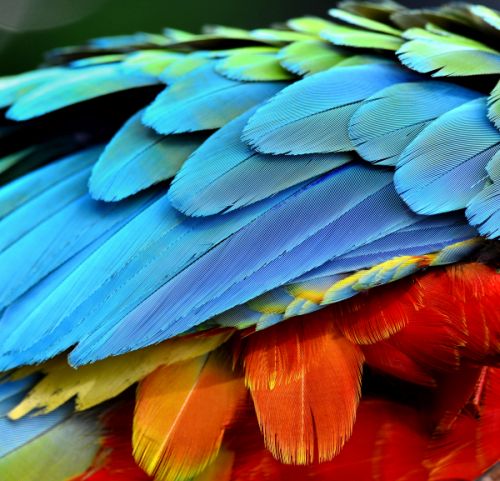“Microstructural architecture” of feathers makes them tough

It has long been known that the feathers on birds are well engineered structures. They are strong, lightweight, aerodynamic, and even when ruffled, they can be preened back into shape readily. This comes from their intricate architecture: feathers have a long central shaft called a rachis, and from this come barbs, which in turn have barbules. In flight feathers, the barbules have hooks that link them to adjacent barbules. Evolutionists once taught that they came from reptilian scales, but this is discredited now, as one evolutionist has pointed out:
At the morphological level feathers are traditionally considered homologous with reptilian scales. However, in development, morphogenesis [shape/form generation], gene structure, protein shape and sequence, and filament formation and structure, feathers are different.1
But why is a feather so tough, and so able to withstand the strong forces during flight? This was explained by a 2017 analysis using an electron microscope by Dr Theagarten Lingham-Soliar (1949—2019),2,3 then of Nelson Mandela Metropolitan University in South Africa.
The rachis is composed of syncitial barbule fibres (SBFs) of keratin running down its length, and held together by a glue-like substance, as well as by hooks and rings—something Lingham-Soliar refers to as a “design strategy”. However, the rachis is thicker at its base and tapers to a thinner end. So, if the SBFs were totally parallel, hundreds of them would need to end before the tip. And each of those ends would concentrate stresses that could start a total break, much as you can tear a plastic packet much more easily if you cut (or bite) a small notch first.
Lingham-Soliar found that going towards the tip, the SBFs don’t terminate in the rachis. Instead, “The solution is a biomechanically ‘ingenious’ and novel architecture of the fibre organization … .”2 At regular intervals, the SBFs deviate left or right and enter the barbs, so the shaft has fewer and fewer SBFs remaining, and tapers off. This avoids the problem of crack-like defects, and reinforces the overall structure by deeply ‘rooting’ the barbs into the rachis.

Of course, there was the normal fact-free homage to evolution, since Lingham-Soliar, though a strong critic of the dinosaur-to-bird dogma, is an evolutionist:4,5
“It is clear that this extraordinary cortical microstructure of the feather has evolved and been perfected over the millions of years of bird evolution.”2
However, evolution didn’t help his research at all, and he failed to present any evidence of partially evolved flight feathers. Instead, he noted that “The most striking analogy of the SBF architecture” involves plants, and the xylem fibres (a major component of wood) undergo a similar diversion from stem to branch. This can’t be explained by a common ancestor of plants and birds!
Furthermore, alluding to the rapidly expanding field called biomimetics or biomimicry,6 he had previously noted (in 2014) that human designers could learn from feather structure,7 and this had been affirmed, he said,2 when two years later micro-engineers called their new 3-D assembled carbon nanotubule beam the “bird feather rachis-like beam”.8 And back in 2013, Lingham-Soliar noted:
The feather aerofoil is unequalled in nature. It is comprised of a central rachis, serial paired branches or barbs, from which arise further branches, the barbules. Barbs and barbules arise from the significantly thinner lateral walls (the epicortex) of the rachis and barbs respectively, as opposed to the thicker dorsal and ventral walls (the cortex). We hypothesized a microstructural design of the epicortex that would resist the vertical or shearing stresses. The microstructures of the cortex and epicortex of the rachis and barbs were investigated in several bird species by microbe-assisted selective disassembly and conventional methods via scanning electron microscopy. We report, preeminent of the finds, a novel system of crossed fibres (ranging from ∼100–800 nm in diameter), oppositely oriented in alternate layers of the epicortex in the rachis and barbs. It represents the first cross-fibre microstructure, not only for the feather but in keratin per se.9
Clearly, the clever design of feathers speaks to us of a clever Designer of feathers!
Re-posted on homepage: 2 August 2023
References and notes
- Brush, A.H., On the origin of feathers, J. Evolutionary Biology 9:131142, 1996 | doi: 10.1046/j.1420-9101.1996.9020131.x. Return to text.
- Lingham-Soliar, T., Microstructural tissue-engineering in the rachis and barbs of bird feathers, Nature: Scientific Reports 7:45162, 2017 | doi:10.1038/srep45162. Return to text.
- Feather design is better than thought, Evolution News, 31 March 2017. Return to text.
- Feduccia, A., Lingham-Soliar, T., and Hinchliffe, J.R., Do feathered dinosaurs exist?: Testing the hypothesis on neontological and paleontological evidence, J. Morphology 266:125–166, 2005 | doi: 10.1002/jmor.10382 Return to text.
- Sarfati, J., ‘Feathered’ dinos: no feathers after all! J. Creation 26(3):8–10, 2012; creation.com/featherless. Return to text.
- See the articles under Scientists copying nature (biomimetics). Return to text.
- Lingham-Soliar, T., Feather structure, biomechanics and biomimetics: the incredible lightness of being, J. Ornithology 155:323–336, 2014 | doi:10.1007/s10336-013-1038-0. Return to text.
- Kazemahvazia, S. and 4 others, Confluent 3D-assembly of fibrous structures, Composites Science and Technology 127:95–105, 2016 | doi:10.1016/j.compscitech.2016.02.034. Return to text.
- Lingham-Soliar, T, and Murugan, N., A new helical crossed-fibre structure of ß-Keratin in flight feathers and its biomechanical implications, PLoS ONE 8(6): e65849, 10 June 2013 | doi:10.1371/journal.pone.0065849. Return to text.








Readers’ comments
Comments are automatically closed 14 days after publication.